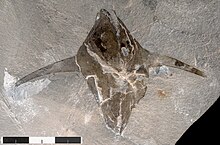121:
134:
104:
260:
in South China, which differs from the type species in the fact that the wings are semicircular rather than blade-like. A possible related form has been reported from the
268:
reaching 11 centimetres (4.3 in) in length. The soft-bodied anatomy is poorly known, though the poorly preserved posterior anatomy of a specimen of
433:
Lerosey‐Aubril, Rudy; Kimmig, Julien; Pates, Stephen; Skabelund, Jacob; Weug, Andries; Ortega‐Hernández, Javier (November 2020). Zhang, Xi‐Guang (ed.).
514:
252:
of Utah. It is unusual among
Cambrian arthropods for having a pair of wing-like structures projecting outwards from the carapace. A second species,
565:
272:
is known, which consists of a narrow segmented abdomen, which ends with a pair of caudal rami. They are thought to have been actively swimming
560:
133:
555:
367:"Soft-bodied fossils from the upper Valongo Formation (Middle Ordovician: Dapingian-Darriwilian) of northern Portugal"
435:"New exceptionally preserved panarthropods from the Drumian Wheeler Konservat‐Lagerstätte of the House Range of Utah"
570:
482:
120:
327:
419:
Robison, R. A. and
Richards, B. C. 1981. Larger bivalve arthropods from the Middle Cambrian of Utah.
462:
402:
347:
309:
128:
328:"New Bivalved Arthropods from Mid-Cambrian Kaili Biota of Southeastern Guizhou, Southwest China"
527:
454:
394:
386:
532:
446:
378:
339:
280:
have been proposed, but the limited knowledge of the anatomy makes the referral tentative.
434:
549:
466:
406:
366:
351:
343:
300:, n. Gen., n. Sp. (Phyllocarida), from the Wheeler Shale (Middle Cambrian) of Utah.”
249:
61:
505:
277:
191:
365:
Kimmig, Julien; Couto, Helena; Leibach, Wade W.; Lieberman, Bruce S. (June 2019).
257:
36:
103:
382:
261:
81:
46:
458:
390:
165:
145:
86:
398:
499:
273:
248:
was described by Brooks & Caster in 1956 from specimens found in the
241:
76:
71:
56:
51:
41:
519:
313:
91:
66:
450:
155:
476:
264:
of
Portugal. They were relatively large, with some carapaces of
480:
326:
Yuan, Jinliang; Peng, Jin; Zhao, Yuanlong (August 2011).
240:
is an extinct genus of bivalved arthropod known from the
276:
organisms. Affinities to the bivalved arthropod group
489:
421:University of Kansas Paleontological Contributions
8:
477:
119:
102:
20:
332:Acta Geologica Sinica - English Edition
289:
296:H. K. Brooks, and Kenneth E. Caster. “
216:
7:
16:Extinct genus of bivalved arthropod
304:, vol. 30, no. 1, 1956, pp. 9–14.
14:
344:10.1111/j.1755-6724.2011.00481.x
132:
219:Pseudoarctolepis semicircularis
1:
566:Fossil taxa described in 1956
561:Fossils of the United States
256:has been described from the
587:
244:period. The type species,
383:10.1007/s00114-019-1623-z
215:
210:
205:Brooks & Caster, 1956
197:
190:
185:Brooks & Caster, 1956
129:Scientific classification
127:
118:
110:
101:
23:
316:. Accessed 12 Dec. 2022.
439:Papers in Palaeontology
302:Journal of Paleontology
298:Pseudoarctolepis sharpi
200:Pseudoarctolepis sharpi
371:The Science of Nature
111:Life restoration of
556:Cambrian arthropods
543:
542:
528:Open Tree of Life
483:Taxon identifiers
451:10.1002/spp2.1307
254:P. semicircularis
233:
232:
227:
186:
578:
571:Fossils of China
536:
535:
523:
522:
510:
509:
508:
491:Pseudoarctolepis
478:
471:
470:
430:
424:
417:
411:
410:
362:
356:
355:
323:
317:
294:
237:Pseudoarctolepis
221:
184:
180:Pseudoarctolepis
177:
137:
136:
123:
106:
96:
33:
29:Temporal range:
25:Pseudoarctolepis
21:
586:
585:
581:
580:
579:
577:
576:
575:
546:
545:
544:
539:
531:
526:
518:
513:
504:
503:
498:
485:
475:
474:
432:
431:
427:
418:
414:
364:
363:
359:
325:
324:
320:
295:
291:
286:
206:
203:
183:
175:
131:
97:
95:
94:
89:
84:
79:
74:
69:
64:
59:
54:
49:
44:
39:
32:Wuliuan–Drumian
31:
30:
27:
17:
12:
11:
5:
584:
582:
574:
573:
568:
563:
558:
548:
547:
541:
540:
538:
537:
524:
511:
495:
493:
487:
486:
481:
473:
472:
445:(4): 501–531.
425:
412:
357:
338:(4): 758–764.
318:
288:
287:
285:
282:
231:
230:
229:
228:
213:
212:
211:Other species
208:
207:
204:
195:
194:
188:
187:
173:
169:
168:
163:
159:
158:
153:
149:
148:
143:
139:
138:
125:
124:
116:
115:
108:
107:
99:
98:
90:
85:
80:
75:
70:
65:
60:
55:
50:
45:
40:
35:
34:
28:
15:
13:
10:
9:
6:
4:
3:
2:
583:
572:
569:
567:
564:
562:
559:
557:
554:
553:
551:
534:
529:
525:
521:
516:
512:
507:
501:
497:
496:
494:
492:
488:
484:
479:
468:
464:
460:
456:
452:
448:
444:
440:
436:
429:
426:
422:
416:
413:
408:
404:
400:
396:
392:
388:
384:
380:
376:
372:
368:
361:
358:
353:
349:
345:
341:
337:
333:
329:
322:
319:
315:
311:
307:
303:
299:
293:
290:
283:
281:
279:
275:
271:
267:
263:
259:
255:
251:
250:Wheeler Shale
247:
243:
239:
238:
225:
220:
217:
214:
209:
202:
201:
196:
193:
189:
182:
181:
174:
171:
170:
167:
164:
161:
160:
157:
154:
151:
150:
147:
144:
141:
140:
135:
130:
126:
122:
117:
114:
109:
105:
100:
93:
88:
83:
78:
73:
68:
63:
58:
53:
48:
43:
38:
26:
22:
19:
490:
442:
438:
428:
423:, 106, 1–28.
420:
415:
374:
370:
360:
335:
331:
321:
305:
301:
297:
292:
278:Hymenocarina
269:
265:
253:
245:
236:
235:
234:
223:
218:
199:
198:
192:Type species
179:
178:
112:
24:
18:
377:(5–6): 27.
258:Kaili Biota
550:Categories
506:Q115690993
284:References
262:Ordovician
166:Arthropoda
467:218995462
459:2056-2802
407:253633957
391:0028-1042
352:129283273
270:P. sharpi
266:P. sharpi
246:P. sharpi
152:Kingdom:
146:Eukaryota
113:P. sharpi
500:Wikidata
399:31129730
274:nektonic
242:Cambrian
162:Phylum:
156:Animalia
142:Domain:
533:4675595
520:4641351
314:1300370
172:Genus:
465:
457:
405:
397:
389:
350:
312:
226:, 2011
224:et al.
463:S2CID
403:S2CID
348:S2CID
310:JSTOR
306:JSTOR
222:Yuan
515:GBIF
455:ISSN
395:PMID
387:ISSN
37:PreꞒ
447:doi
379:doi
375:106
340:doi
552::
530::
517::
502::
461:.
453:.
441:.
437:.
401:.
393:.
385:.
373:.
369:.
346:.
336:85
334:.
330:.
308:,
87:Pg
469:.
449::
443:6
409:.
381::
354:.
342::
176:†
92:N
82:K
77:J
72:T
67:P
62:C
57:D
52:S
47:O
42:Ꞓ
Text is available under the Creative Commons Attribution-ShareAlike License. Additional terms may apply.

